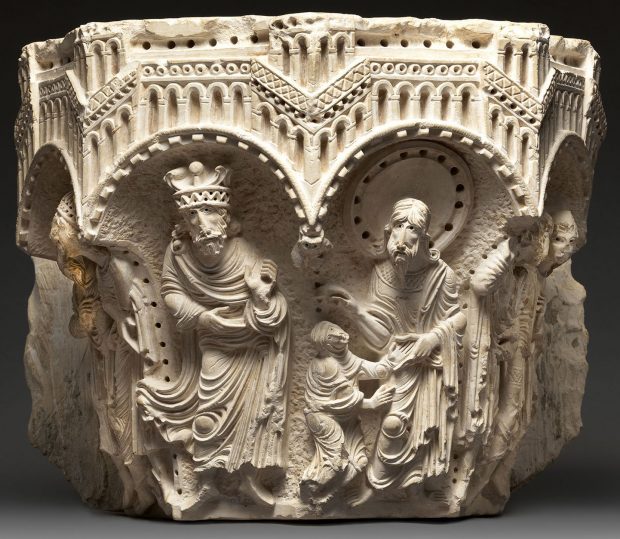This exhibition makes objects and art made by and for Jerusalem’s competitive, faith-defined communities in the later Middle Ages – the ‘every people under heaven’ of the title – speak to lives that are still affected by that city of life, imagination, and hope. Expansive, near encyclopaedic within its limits, and very beautiful, the exhibition produces an immersive experience of the city itself. We are encouraged to meander through the six main galleries as if through the old city and the stagecraft begins in the vestibule. Here, in a dramatically darkened open space, two walls are filled with smoggy, panoramic views of the contemporary city, filmed live and broken into irregular, discrete units.
The curators manoeuvre through the complexities of this past evenhandedly. They have made a conscientious effort, they state, to tell no one’s story at the expense of another’s, and they have selected a memorable range of objects, which tell stories across the divides between the major faiths that look to Jerusalem – and within the faiths themselves.

Reliquary cross of Jacques de Vitry; cross: Acre, soon after 1216; base: Oignies, after 1228. Musée Provincial des Arts Anciens du Namurois, Belgium
The opening gallery, which deals with trade and tourism, is a compelling example of this approach. The choice of theme might seem to reduce unity of purpose among Jews, Muslim, and Christians in this period to economic self-interest, but the mixture of the mercantile and imagined aspects of this room is the most challenging and thought-provoking display in the exhibition. The European and Middle Eastern maps, in Latin and Arabic, show how differently the region could be conceptualised. Strongly focused lighting and intrusive vitrines make the encounter at times awkward. The show consistently aestheticises the objects it displays: pottery and metalwork from hoards are shown in the same manner as high-end production. But the wide-ranging (and lovely) goods and objects here show that Jerusalem was a centre of commerce and a node in a much larger web of economic activities than our sources – typically interested in other, higher matters – would let us see. Three astrolabes with inscriptions in Arabic, Judeo-Arabic, and Latin each use Jerusalem among their coordinates, and the (ultimately unknowable) reasons for its inclusion in each case opens up a complex, deep geography that the rest of the exhibition continues to probe. The exhibition’s five subsequent divisions, which include holy war, patronage, and Jerusalem’s eternal promise, appear to be natural organising principles, at first glance. Pluralism, however, ought not to be confused with sharing or understanding.

The Book of Divine Service, From the Mishneh Torah of Maimonides. Northern Italy, c. 1457. Image: © The Metropolitan Museum of Art, New York
Many objects are being seen outside Jerusalem for the first time. The Greek Orthodox Patriarchate Museum, which has been difficult to access for many years now, has loaned some of its treasures. Other communities in the city have also also put their best foot forward: the Franciscans have loaned, and allowed to be cleaned, five of the magnificent capitals from the Basilica of the Annunciation at Nazareth. Here, higher, more legible and brighter than they are displayed in the cramped museum at Nazareth, their exquisite, lively carving, which is remarkably well preserved, can be seen clearly.
Objects borrowed from Namur in modern-day Belgium demonstrate the connections to the Holy Land of the famous churchman and writer Jacques de Vitry (he was a bishop of Crusader Acre), and his crozier, ring, reliquary cross and boxes make an impressive and unusual biographical cluster. Manuscripts are a strong presence in all the galleries and they represent the most beautiful expressions of social and religious desires for realising, convincing, and owning Jerusalem through art. The final two rooms display leaves from the Timurid Paths of Paradise (c. 1465) with scenes of Muhammad encountering Jerusalem, along with Catalonian Bibles in Hebrew, and Haggadah from the 14th century. The mid 13th-century Ambrosian Bible with marvellous Ethiopian and Armenian complements leads to a moving crescendo.

Miniature (detail) from a copy of al-Sarai’s Nahj al-Faradis (The Paths of Paradise), Iran, Herat. David Collection, Copenhagen
The exhibition succeeds wonderfully in this way, and yet some hesitation should remain in thrilling to messianic pleasures, however vicariously. The challenging qualities of Jerusalem as a holy place need to be recognised, because they determine us still, even if the curators and museum might wish to downplay these aspects. But in any exhibition of this scale and prestige, the important disputes over archaeology in the city need to be acknowledged, such as those in the so-called City of David, as well as the controversial movement of objects out of the Palestine Archaeological Museum (aka the Rockefeller Museum). We should not let the beauty of the objects in a show like this blind us to the difficult demands of the modern-day city, in all its broken, yet splendid forms.
‘Jerusalem 1000–1400: Every People Under Heaven’ is at the Metropolitan Museum of Art, New York from 26 September–8 January 2017.
From the December issue of Apollo. Preview and subscribe here.
Unlimited access from just $16 every 3 months
Subscribe to get unlimited and exclusive access to the top art stories, interviews and exhibition reviews.














![Masterpiece [Re]discovery 2022. Photo: Ben Fisher Photography, courtesy of Masterpiece London](http://www.apollo-magazine.com/wp-content/uploads/2022/07/MPL2022_4263.jpg)
It’s time for the government of London to return to its rightful home